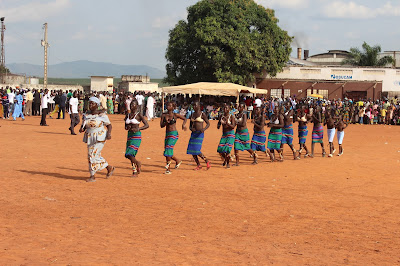The Massa who are often called « Banana » live on the flood plains bordering the middle course of the Logone River about 155 miles south of N’Djamena. In the 70’s, there were about 75 000 Massa in Cameroon and about 50 000 in the Republic of Chad. More recent statistics released by The Joshua project give an estmate of about 488 000 accross the world.
 |
| Joyful moments |
The Masa build their enclosures on land above the flood line and keep their cattle near their huts only during dry season.
In rural areas, they live by farming, fishing and raising livestock. They have a balanced diet, which is rare in the center of the savanna. The principal agricultural product is quick-growing red sorghum, which is grown on level ground during the rainy season. Millet, sorghum requiring transplanting peanuts, rice, beans and peas are subsidiary products. Fishing is carried on all year round in the Logone and its tributaries. When the floods subside, the men organize fishing expeditions in the lower courses of the Logone and Chari Rivers. In addition, they raise goats, sheep and small zebus. The latter are an important part of the economic and community life of the massa. Owners of zebus enjoy high social status : first, because a man is required to give ten fertile cows to the family of his future wife before he can marry her and second, heads of families extend the network of their social and commercial relations by building up a complex system of lending cattle.
The taking of a milk treatment by oneself or one’s children is also considered to be a sign of wealth. When a person goes in for such a treatment, he stops working and drinks large quantities of milk and sorghum gruel to get fat. He spends the best part of the day attending to his appearance and physique in preparation for the wrestling, singing and dancing which are part of the festivals of the dry seasons.
The Massa are skillful basketmakers who use the reeds in the flood areas. The lack of trees and stones has caused them to master the art of making cob (mixture of clay and straw), which they use for the walls of their huts and furniture.
Lox-wax processors
They know how to work iron and copper, which the blacksmiths make into bracelets and pipes by means of the lost-wax process.
They do not use bows but employ assegais and throwing knives. The most common weapon i sis the cudgel, and a man is never without one. Formerly it was used for what may truly be called « fencing », practiced with heads protected by padded helmets.
Marriage
The political organization of the Massa hardly goes beyond the framework of patrilineal lineages. Preferential marriage- marriage to someone of a particular parentage- does not exist. Rather marriage is exogamous and people are requiered to marry outside their patrilienage and communal residence. The massa follow the practice of levirate- marriage the widow of one’s brother.
The administrative division of the country into cantons, villages and districts marks the former divisions into lands occupied by members of the same patrilienage. Within the lineage, the elders and the land chief, elected by descendants of the founder-ancestor, wield the highest authority.The land chief supervises the division of the fields and decides when the main agricultural operations should begin.
It is also incumbent on him to performs the rites and sacrifices on which the prosperity of the community depends, and to win the favor of the ancestors and the different genii. The powers of the other world include : laona, a beneficient god who lives in the sky and sends the rains ; nagata, mother earth ; matna, the genius of death ; and mounounda, the genius of water. Soothsayers are constantly requiered to decide the nature and purpose of the sacrifices that must be performed to appease the powers above. Their systems of divination consist in arranging several hundred signs in spirals on the ground. For hundreds of years, the Massa have used an initiation similar to that of the Yondo, one of neighboring sara tribes. In their general development, though, the Massa tend to follow the example of the muslim societies (fulani and bagirmi) with whom they live.
I.G
With notes by Igor de Garine
 |
| Welcoming visitors on a Masa land. |
 |
| Women make selling millet and sorghum in Yagoua market |
 |
| Diverse herbs by a traditional doctor. |
 |
| Female dance |
 |
| Appreciating a work of art |






Commentaires
Enregistrer un commentaire